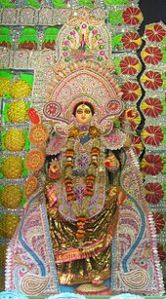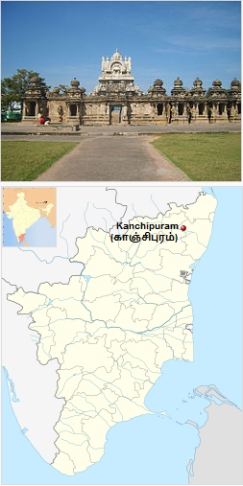Indrakshi Shakti Peethas
Place
Nainativu (Manipallavam), Northern Province, Sri Lanka. Located 36 km from the ancient capital of the Jaffna kingdom, Nallur. The murti of the Goddess is believed to have been consecrated and worshipped by Lord Indra. The protagonist, Lord Rama and antagonist, Ravana of the Sanskrit epic Ramayana have offered obeisances to the Goddess. Nāga and Garuda of the Sanskrit epic Mahabharata; resolved their longstanding feuds after worshipping this Goddess.
Body Part or Ornament
Silambu (Anklets)
Shakti
Indrakshi (Nagapooshani / Bhuvaneswari)
Bhairava
Rakshaseshwar (Nayanair)
In Hinduism, Bhuvaneshvari (also spelt Bhuvaneswari) (Sanskrit: भुवनेश्वरी, Tamil: புவனேஸ்வரி) is the fourth of the ten Mahavidya goddesses and an aspect of Devi,as elements of the physical cosmos, in giving shape to the creation of the World”. Also Bhuvaneswari is considered as the supreme goddesses who creates everything and destroys all the unnecessary evils of world. She is also considered as the Mother goddess of Kali, Lakshmi, and Saraswati also Gayatri. In Hindu Mythology she is considered as the most powerful goddess in the universe. Parvati is Sagun Roop of Goddess Bhuvaneswari. Her bija mantra is “Hreem.”
Bhuvaneshwari: The Queen of the Universe. Bhuvaneshwari means the Queen or ruler of the Universe. She is the Divine Mother as the Queen of all the worlds. All the Universe is her body and all beings are ornaments on her infinite being. She carries all the worlds as a flowering of her own Self-nature. She is thus related to Sundari and to Rajarajeshwari, the supreme Lady of the Universe.
She is also known as Adi Shakti i.e one of the earliest forms of shakti. She is capable of turning situations according to her wish. It is considered that even the navagrahas and trimurtis cannot stop her from doing anything. She can order the Trimurtis to do anything she wants.
Temples
There are several temples dedicated to Bhuvaneshwari across India, however, the most important (Shakti Peetha) is located in Nainativu (Manipallavam) – off the shore of the Jaffna Peninsula in Northern Sri Lanka. She is regarded as the main shakti of Lord Lingaraj, in Bhubaneswar. She is worshipped as the patron goddess of Bhubaneswar and by Utkala Brahmins of Orissa. A small shrine is also dedicated to her inside Jagannath Temple, Puri and Devi Subhadra is worshipped as Bhuvaneshwari.The Samaleswari shrine and Cuttack Chandi Temple in Orissa too are dedicated to her. The Kamakhya Temple too houses Bhuvaneshwari Temple.In South India most of the Srividhya tradition upasaka worship her.In Kerala she is also popular among Shaktas
In North America, Devi Bhuvaneshwari is worshipped at Parashakthi Temple in Pontiac, Michigan. Here the Goddess Vigraha is made with panchaloha – five auspicious metals with and energized by Dr. G Krishna Kumar using Yanthra Prana pratheeshta in November 2005.[1]
Kamakshi Mata Temple
Place
Kanchipuram, Kamakshi temple, Kamakoti Peetam mentioned in Lalita Sahasram, Trishati, Astothram etc.
Body Part or Ornament
Ottiyana (Ornament covering stomach)
Shakti
Kamakshi
Bhairava
Kaal Bhairav
Kanchipuram or Kanchi, is a famous temple city in the Indian state of Tamil Nadu. It served as the Capital city of the Pallava Kingdom. It is also known by its former names Kanchiampathi, Conjeevaram, and the nickname “The City of Thousand Temples”.[1] It is now the Administrative headquarters of Kanchipuram district. Kanchipuram is located 72 kilometers from Chennai, the capital city of the southern state of Tamil Nadu, India.
Kanchipuram is considered one of the seven holiest cities to the Hindus of India.[2] In Hinduism, a kṣetra is a sacred ground, a field of active power, a place where moksha, final release can be obtained. The Garuda Purana enumerates seven cities as providers of moksha, namely Ayodhya, Mathura, Haridwar, Varanasi, Avantikā, Dvārakā and Kanchipuram.[3]
Among the major Hindu temples in Kanchipuram are some of the most prominent Vishnu Temples and Shiva Temples of Tamil Nadu like the Varadharaja Perumal Temple for Vishnu and the Ekambaranatha Temple which is the “earth abode” of Shiva. Kamakshi Amman Temple, Kumara Kottam, Kachapeshwarar Temple, and the Kailasanathar Temple are some of the other prominent temples.
Etymology
Legend is said to provide eternal happiness to those who visit the city. It is said that “Ka” (Brahma) “anchi” (worshipped) Hindu God Vishnu at this place, which is why the city was given the name Kanchipuram (puram meaning “city).” Kanchipuram is located 71 km (45 miles) southwest of Chennai and 64 km west of Mamallapuram on the Palar River.
Geography
Kanchipuram is located at 12.98°N 79.71°Eat a distance of 76 km south-west of Chennai, on the banks of River Vegavathi, a tributary of Palar river at an elevation of 83.26m above the sea level.[6] The town covers an area of 11.60 km2 and has a natural slope towards Manjal Neer Channel and towards river Vegavathy in the south. Predominant soil types found in this area are black, red loam, clay and sand, suitable for constructional activities.[6] The weather is hot and humid, reaching a maximum (Average) of 37.5 degree Celsius during April to July the minimum (Average) of 20.5 degree Celsius during the months of December to February. The town receives an average of 1064 mm of rainfall, 68% from the northeast monsoon.[6]
Demographics
As of 2001 India census,[7] Kanchipuram had a population of 152,984. Males constitute 50.37% of the population and females 49.63%.[8] Kanchipuram has an average literacy rate of 75%, higher than the national average of 59.5%: male literacy is 81%, and female literacy is 69%. In Kanchipuram, 10% of the population is under 6 years of age.
Country: India
State: Tamil Nadu
District(s): Kanchipuram
Website: http://kanchi.tn.nic.in
MAP: Google Click Here

